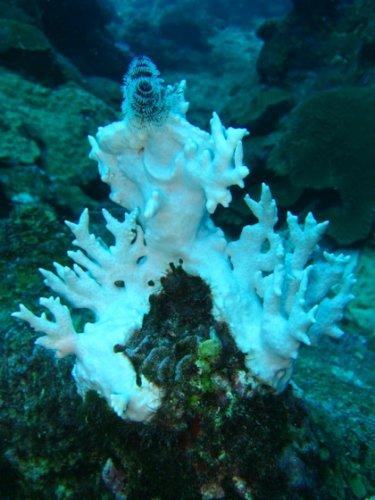Decades of "bleaching" events and diseases have been devastating to coral reefs surrounding national parks in the Caribbean and off South Florida, so much so that the losses are akin to "losing the Redwoods."
While warming ocean waters this year have some researchers worried that 2010 could produce the worst coral bleaching event on record, one that could further damage reefs around popular parks such as Virgin Islands National Park, Biscayne National Park, and Dry Tortugas National Park and greatly impact the experience of divers and snorkelers in those waters, much of the damage has already been done.
Coral bleaching occurs when warmer than normal ocean waters stress the corals, and they in turn push out their "zooxanthellae" algae that give the corals their distinctive colors. If temperatures are warm enough for long enough, the corals themselves die, leaving behind white, or bleached looking, skeletons. While such bleaching has been noticed in localized areas for roughly the past century, since the 1980s it has been noticed around the globe, according to NOAA. (Disease, pollution, and physical damage also can weaken or kill corals).
At the National Park Service's South Florida/Caribbean Network, Matt Patterson said Monday that today's expanse of live coral reefs in that region is but a fraction of what it was in the 1960s and 1970s, when live organisms inhabited roughly 60-80 percent of the region's reefs. In some places today reefs have as little as 10 percent or less of the live stony corals, the principal reef builder required for reef success, the marine scientist said.
“Reefs that people visit now are graveyards, are just skeletons," Mr. Patterson said.
When you realize that many of the coral reefs are 500-600 years old -- “Some of these larger corals were around when Columbus was sailing around the Caribbean” -- losing them to bleaching events and, at times, ensuing disease, is "like losing the Redwoods," he added.
That background adds some perspective to recent news from the National Oceanic and Atmospheric Administration's Coral Reef Watch arm that "we are nearing the end of thermal stress capable of causing significant coral bleaching in the southern Caribbean in 2010."
In other words, while it's good that waters are cooling in the Caribbean, much of the damage already has been done in recent decades.
"There's just not a lot (left) to be impacted," pointed out Mr. Patterson.
What helped buffer the corals around the Virgin Islands from high water temperatures this year were tropical storms that literally mixed things up. Not only did their associated cloud cover and rains help cool off the ocean waters, but strong winds brought an upwelling of cooler waters that took the edge off, temperature-wise, according to the scientist.
“That kind of resets the temperature clock quite a bit,” he explained.
Unfortunately, coral bleaching episodes in 1998, 2002, and 2005 (when, according to NOAA, the average temperature of the Caribbean waters exceeded "the average temperatures seen over the past 150 years) did vast amounts of damage to the reefs that lure divers and snorkelers in search of schooling blue tang, and yellow sergeant majors, solitary parrotfish, colorful sponges, fans, and dozens of other marine species that rely on reefs for both food and protection.
While some reefs can bounce back relatively quickly, others can take years or decades to rebound.
“We’re just relying on what we see in the field and scratching our heads, asking why is that one looking so good while the other ones didn’t do so well,” said the scientist.
Mr. Patterson and colleagues in Florida, the Virgin Islands, and Hawaii recently put together a "snapshot" of how bleaching, disease, and other impacts were affecting reefs at eight units of the National Park System. Those overviews are somewhat sobering in how they assess the extent of damage that has taken place.
For instance, the 2005 bleaching event, which featured warming waters and ensuing disease, diminished the extent of live stony coral cover at Virgin Islands National Park in the range of 32 percent-64 percent. At the nearby Buck Island Reef National Monument, live coral cover at two sites shrank from 6 percent and 17 percent to 3 percent and 5 percent during the same period.
While stony coral cover is low at Biscayne National Park, averaging just 5 percent-8 percent at selected sites, its waters were not impacted by the 2005 bleaching event.
And while coral cover at Kaloko-Honokohau National Historical Park is a relatively high 32 percent, the researchers noted that the growth of new corals has been "extremely low" in recent years.
At National Park of American Samoa, coral cover in 2008 was noted across 22 percent of 30 monitoring sites, but "(B)leaching events occurred in 1994, 2002, and 2003, which affected both shallow and deep corals. There has also been minor bleaching in back reef pools and lagoons for the past three years."
When you consider the role of reefs -- nurseries for some marine life species, food sources for others, habitat for still others, and protection for shorelines -- the news is not encouraging.


 Support Essential Coverage of Essential Places
Support Essential Coverage of Essential Places







Comments
When one considers how the warming climate has provided opportunities for insects to decimate old-growth pines in Shenandoah, Great Smoky Mts, Yellowstone, and Rocky Mtn, not to mention the disapprearing glaciers in Glacier NP, this is pretty depressing news.